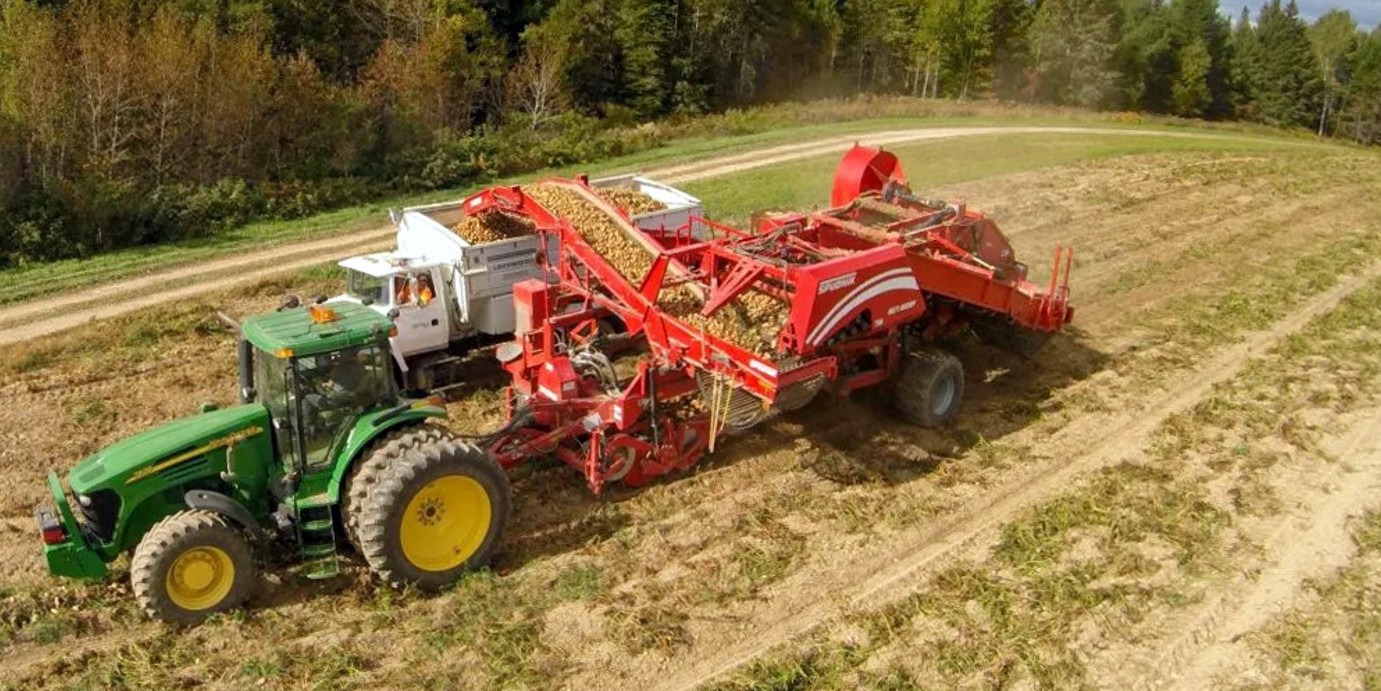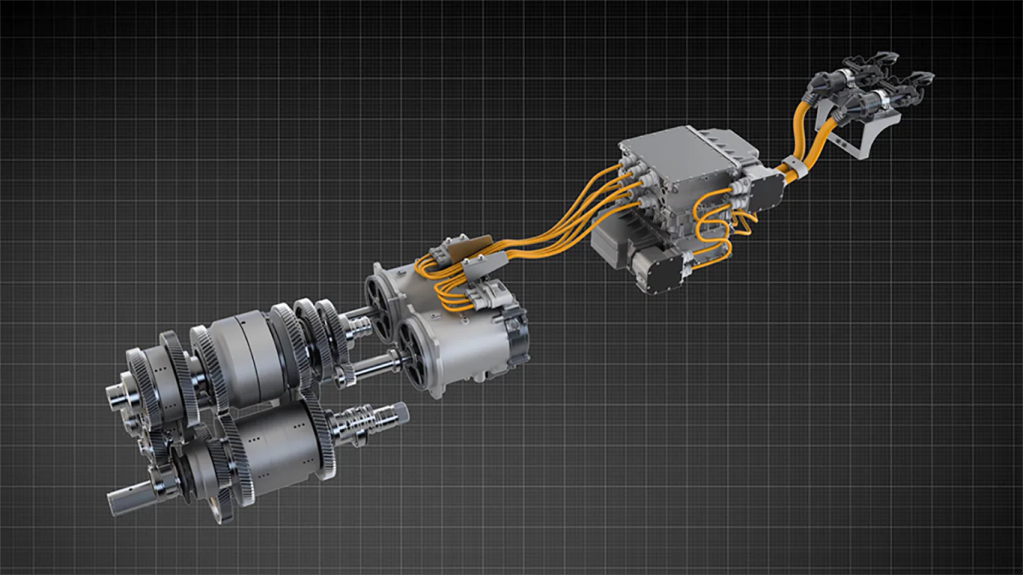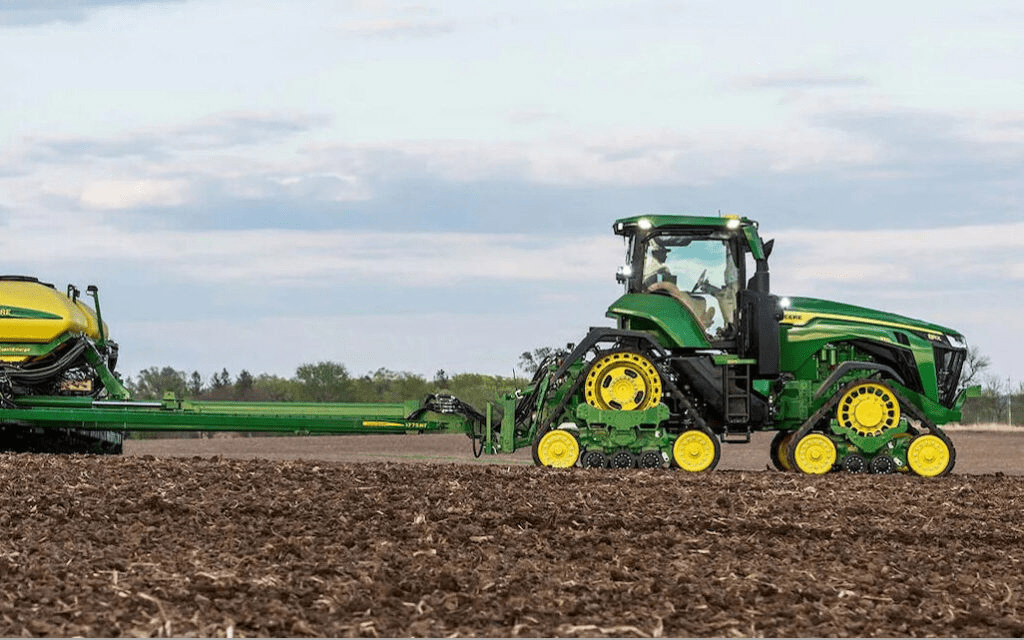
John Deere is offering an Electric Variable Transmission (EVT) on its larger 8 and 9 series model tractors that replaces a standard mechanical variable transmission with electric motors. Now, they’re partnering with Spudnik to put the system to work on potato and root crop farms.
Naturally, Deere cites a number of advantages to using its tech — including more efficient operation, infinite speed control, reduced maintenance requirements, and superior torque delivery “to the wheels.” The ag equipment experts at Agriland, however, cite yet another benefit to the EVT that’s often overlooked: off-boarding.
“(One of) the virtues of this (EVT) approach is getting power to the wheels … but another notable benefit of this arrangement is that an electrical power source is readily available to drive implements, which is now generally referred to as off-boarding,” writes Justin Roberts. “The various driveshafts and belts on a trailed machine, such as a baler, can be replaced with wires and motors which are lighter and do not require the heavy engineering necessitated by tensioned pullies and the torque reaction of shafts.”
John Deere EVT cutaway

Deere notes that agricultural implements with powered axles are already successfully used in Europe, where they help to “push” the tractor from behind while working in the field. In addition to improving traction and preventing tractors from getting stuck in inclement weather, the EVT-powered axles theoretically enable a smaller tractor to effectively pull a larger implement.
“This EVT is the industry’s only transmission that enables electric power generation (up to 100kW),” says Ryan Jardon, marketing manager for John Deere. “By using this electricity farmers could power implement fan drives, take the place of implement hydraulic pumps, or assist the tractor by powering the implement’s axles. This is similar, to proven-technology John Deere currently uses, on construction equipment.”
By now, though, you’re probably wondering what any of this has to do with potato farming. It turns out that electrification, whether we’re talking about fully electric drive or a diesel/EVT hybrid, solves a huge problem in root crop harvesting.
Using air to separate roots and tubers from dirt clods and stones is a common practice on mechanical harvesters, but maintaining a consistent airflow with a diesel engine that’s under differing loads throughout its duty cycle, constantly varying engine speeds, and — as a consequence — fan revolutions is a constant problem. Working with Deere, Spudnik has solved this problem by driving its fans with an electric motor that’s powered with off-boarded electricity from the EVT, rather than a mechanical connection to the tractor’s transmission (how it’s been done for the better part of a century).
Electrifying the fan motor means it can run at a constant speed, regardless of how fast, or how slow the tractor is running.
The configuration has already been tested on one of Spudnik’s 6621 2 Row AirSep potato separators with a large grower out in Washburn, Maine with great success, according to Spudnik. No word yet on when they’ll get serious and roll out to Idaho.
Electrek’s Take

Top comment by Eco Logical
Diesel locomotives have been hybrid for at least 60 years because this combination eliminates the need for a mechanical transmission.
What's taking so long for agriculture and other industries to realize the savings?
John Deere knows that its core buyers are wary of new technology — and even talking about a fully electric tractor is one of those things that could sour a longtime customer relationship in some parts of the country. Deere is doing a smart thing here by developing the EVT, electrifying their ag equipment’s drive units and offering several of the benefits of full electric operation without taking away all the rattling vroom-vroom diesel noises that their current customers love.
Think of the EVT, then, as a PHEV for farmers. Once they understand that they’re already driving an electric tractor and pulling electric implements with electrically driven axles, the only question will be how those motors get the electrons they need to do the work. Will it be from a diesel generator/alternator, as in the EVT, or a battery?
Sooner than later, the sheer economics of battery power will make switching a no-brainer. Until then, clever tech like the EVT is laying the foundations by playing up the benefits of EVs without using any politically charged terms. And— hey, whatever works.
FTC: We use income earning auto affiliate links. More.

Comments